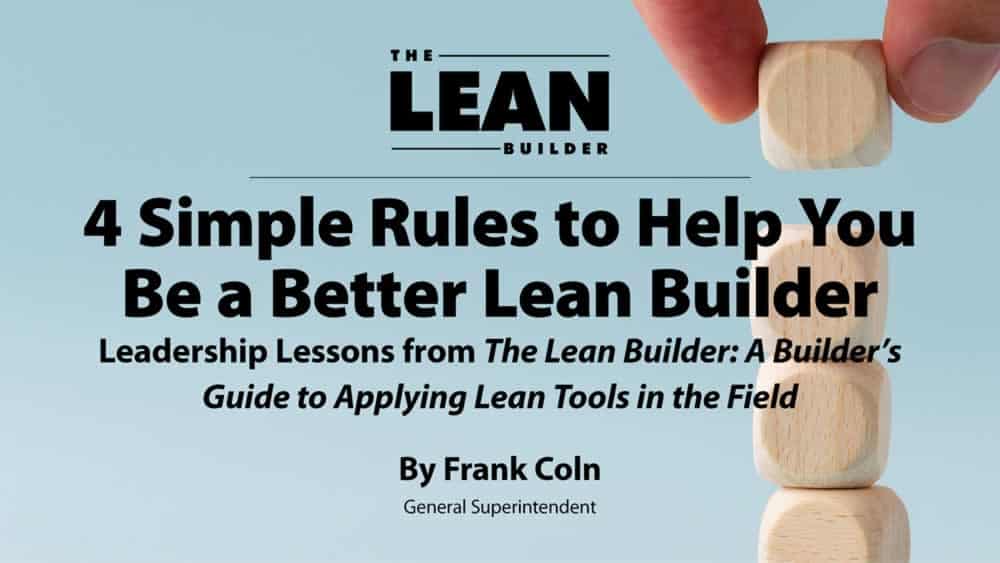I’ve used The Lean Builder: A Builder’s Guide to Applying Lean Tools in the Field exclusively to explain the whys and hows of LCI’s Last Planner System® (LPS). After taking a deeper look into the steps that the main characters Alan and Sam took to implement LPS, it became clear that the book also offers some great leadership lessons on how to get buy-in from the trade partners on your project.
Leadership Lessons
Coaching people to learn and use different techniques is hard in any environment. From the sports world to corporate development, we are all looking for a way to improve how we coach and teach others to be great. The Lean Builder describes Alan as the experienced, old-school superintendent who mentors Sam, the younger superintendent trying to lead his team to a successful project.
Alan used four basic theories to coach Sam through implementation of LPS. I do, you watch. I do, you help. You do, I help. You do, I cheer.
I DO, YOU WATCH.
In the book, Alan shows up to Sam’s job to help him with his project. Alan’s years of experience allowed him to immediately address the typical issues of standard subcontractor weekly meetings. His advice for Sam was to encourage him to implement daily huddles. The reason Sam was able to implement daily huddles the next day was due to Alan’s coaching. Alan simply took the opportunity to walk through the five topics of daily huddles with the drywall foreman. Sam was able to watch the interaction and then discussed the why and how of the process with Sam.
LESSON LEARNED: Lead by example, discuss the process to ensure details are understood, and explain how it helped you improve.
I DO, YOU HELP.
As Sam struggles to maintain consistent daily huddles, Alan shows up to Sam’s project again. Sam complains about the trade partners attitude toward the LPS process. Alan addressed Sam’s complaints about the trade partners by showing empathy. He also brought and set up the visual board system to implement LPS, and he asked for Sam to help and define the process. This created buy-in and motivated Sam to continue. Sam felt like he could own this new process.
LESSON LEARNED: Be empathetic when coaching others and understand set-backs will happen. The leader/coach needs to be there to support those he is teaching so that they can be comfortable with new processes.
YOU DO, I HELP.
As Sam continued to implement LPS, he began to struggle with resolving RFI issues. Sam remembered Alan’s coaching regarding the constraint log and began to use it on his project. On Alan’s next jobsite visit, he complimented Alan’s use of the constraint board. After Sam complained about items not being resolved, Alan simply offered some guidance to make Sam feel comfortable about working with his design team to resolve them.
LESSON LEARNED: The leader needs to be there to provide assistance when things get tough. Always make time to follow up and address issues that someone has when trying a new process. If Alan had not made time to follow up with Sam, he may have been fired for his attitude when dealing with the design team.
YOU DO, I CHEER.
After Alan had shown Sam the pull planning process and weekly work planning processes, Sam had another set back on his project. Instead of Alan showing Sam what and how to do things to get back on track, he used leading questions to allow Sam to figure out the best approach moving forward. Sam remembered what Alan had previously shown him and, through Alan’s questioning, Sam chose to stick with the LPS process. Alan was present at the next couple project meetings. Some leaders would step in to “save the day” by taking over and doing the process themselves. Alan chose to take a back seat. He offered supportive comments as he observed Alan and the project team working on a solution.
LESSON LEARNED: The leader does not have to step in to solve problems themselves. Once they have learned the process and are using the process, the leader needs to cheer the team on as they make progress toward solving their problem. You’ve coached them to the point where they can use the process to solve their problems. Do not erase all the progress by jumping in to save the day.
Leadership Lessons Learned
These four ideas are demonstrated over and over again in The Lean Builder: A Builder’s Guide to Applying Lean Tools in the Field. They are the basic steps Alan took to lead Sam to a place where he is comfortable being a leader on his project using LPS. Alan did not only help Sam with his project, he turned Sam into a leader as well.
Developing leaders within the construction industry is hard to do. By breaking it down into these four steps, we can develop future leaders that will continue to improve our construction processes.
I want to encourage you to re-read The Lean Builder: A Builder’s Guide to Applying Lean Tools in the Field. Be sure to pay attention to the leadership style Alan uses to teach Sam. I overlooked this aspect of the book at first because I was more focused on the hows and whys of LPS implementation. We all need help to be better leaders, and Alan’s approach in the book works in real life, too.









